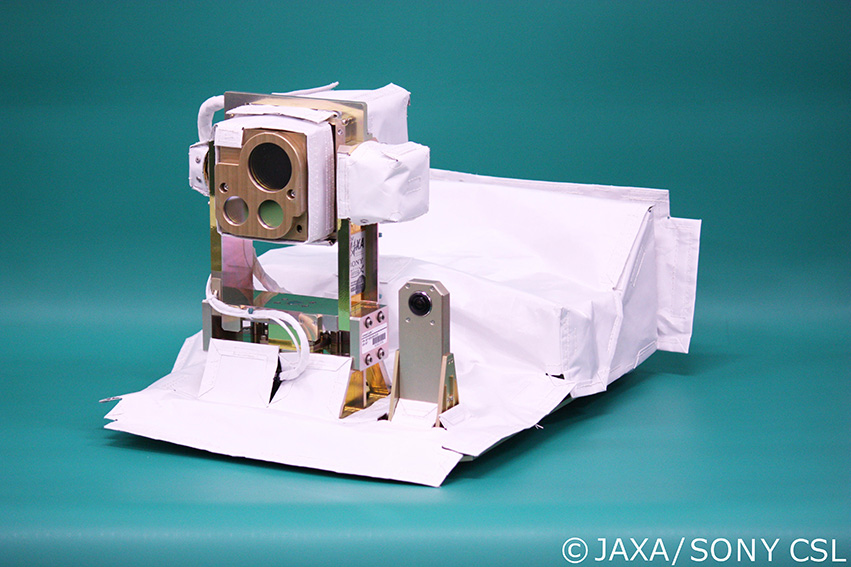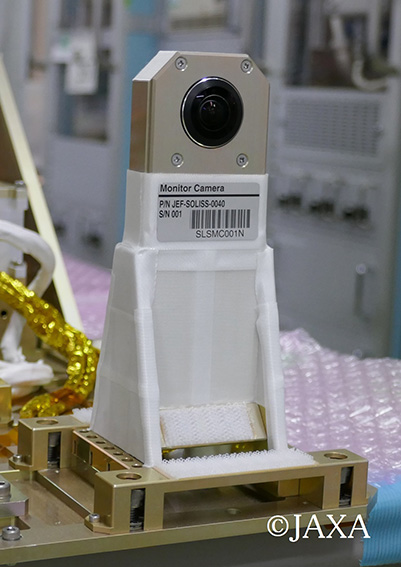- Home
- News Release
- News archives (2019)
- JAXA and Ricoh jointly develop a compact spherical camera for use in outer space
News Release
JAXA and Ricoh jointly develop a compact spherical camera for use in outer space
- August 28, 2019
TOKYO, August 28, 2019 – The Japan Aerospace Exploration Agency (JAXA) and Ricoh Company, Ltd. (Ricoh), today announced that they have jointly developed a spherical camera that can be used in outer space (outside the spacecraft) to capture 360-degree spherical images in a single shot.
This camera will be used as to monitor the operation of the biaxial gimbal of the SOLISS (Small Optical Link for International Space Station)*1. It will be carried aboard the H-II Transfer Vehicle (HTV8) “KOUNOTORI-8”, the cargo transporter to the International Space Station (ISS), which is scheduled for launch on September 11th, 2019. It will shoot spherical pictures and videos from the Exposed Facility of the Japanese Experiment Module (JEM) “Kibo” and send them to ground stations. This camera was developed from a consumer product, and is the world's smallest 360-degree camera that can be used in outer space. In addition, it is the first time that this 360-degree camera based on a consumer product from Japanese company will take spherical images in outer space.
JAXA and Ricoh have jointly developed this camera under a Memorandum of Understanding (MOU) signed in 2018 to mutually cooperate. The camera was based on Ricoh's compact spherical camera RICOH THETA*2, and JAXA has taken measures on this camera for use in space to withstand the heat and radiation. Given the compact size and light weight of this camera, as well as the fact that the camera can shoot 360-degree spherical images in a single shot, it is useful to get a lot of visual information in outer space.
JAXA aims to further utilize this technology as a monitor camera to be attached outside a spacecraft. Ricoh will expand the use of its 360-degree cameras and related services to a wider variety of industries. It will also contribute to the development of science and society, including space development, through technology research and development.
- *1
- Small Optical Link for International Space Station: JAXA and Sony Computer Science Laboratories, Inc. jointly developed a long-distance laser communication system under the Request for Proposal (RFP) joint study framework of the JAXA Space Exploration Innovation HUB Center*3, with the aim of establishing a real-time, mass-data communication system for future inter-satellite communications and communications with ground stations.
- *2
- RICOH THETA external dimensions (excluding lens): 44mm (W) × 130mm (H) × 22.9mm (17.9mm) (D)
- *3
- A project which JAXA has been commissioned by the Japan Science and Technology Agency (JST) under its innovation hub start-up program. (“Open Innovation Hub for Expanding Humanosphere and the Domain of Human Activity through Solar System Frontier Development”)
Relevant Contents
News release in PDF format
| About Ricoh |
Ricoh is empowering digital workplaces using innovative technologies and services enabling individuals to work smarter. For more than 80 years, Ricoh has been driving innovation and is a leading provider of document management solutions, IT services, communications services, commercial and industrial printing, digital cameras, and industrial systems.
Headquartered in Tokyo, Ricoh Group operates in approximately 200 countries and regions. In the financial year ended March 2019, Ricoh Group had worldwide sales of 2,013 billion yen (approx. 18.1 billion USD).
For further information, please visit www.ricoh.com
###
© 2019 RICOH COMPANY, LTD. All rights reserved. All referenced product names are the trademarks of their respective companies.

